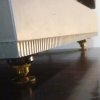Fiftyfifty
Well-Known Member
Hi,
Has anyone tried:
Auralex Acoustics ISO-Tone Turntable Isolation Platform?
Is it useful? Is it effective? Does a heavy turntable with a solid plinth need an isolation platform? Any recommendations for a good tt isolation platform? Any used one available for sale?
Thanks
Has anyone tried:
Auralex Acoustics ISO-Tone Turntable Isolation Platform?
Is it useful? Is it effective? Does a heavy turntable with a solid plinth need an isolation platform? Any recommendations for a good tt isolation platform? Any used one available for sale?
Thanks


